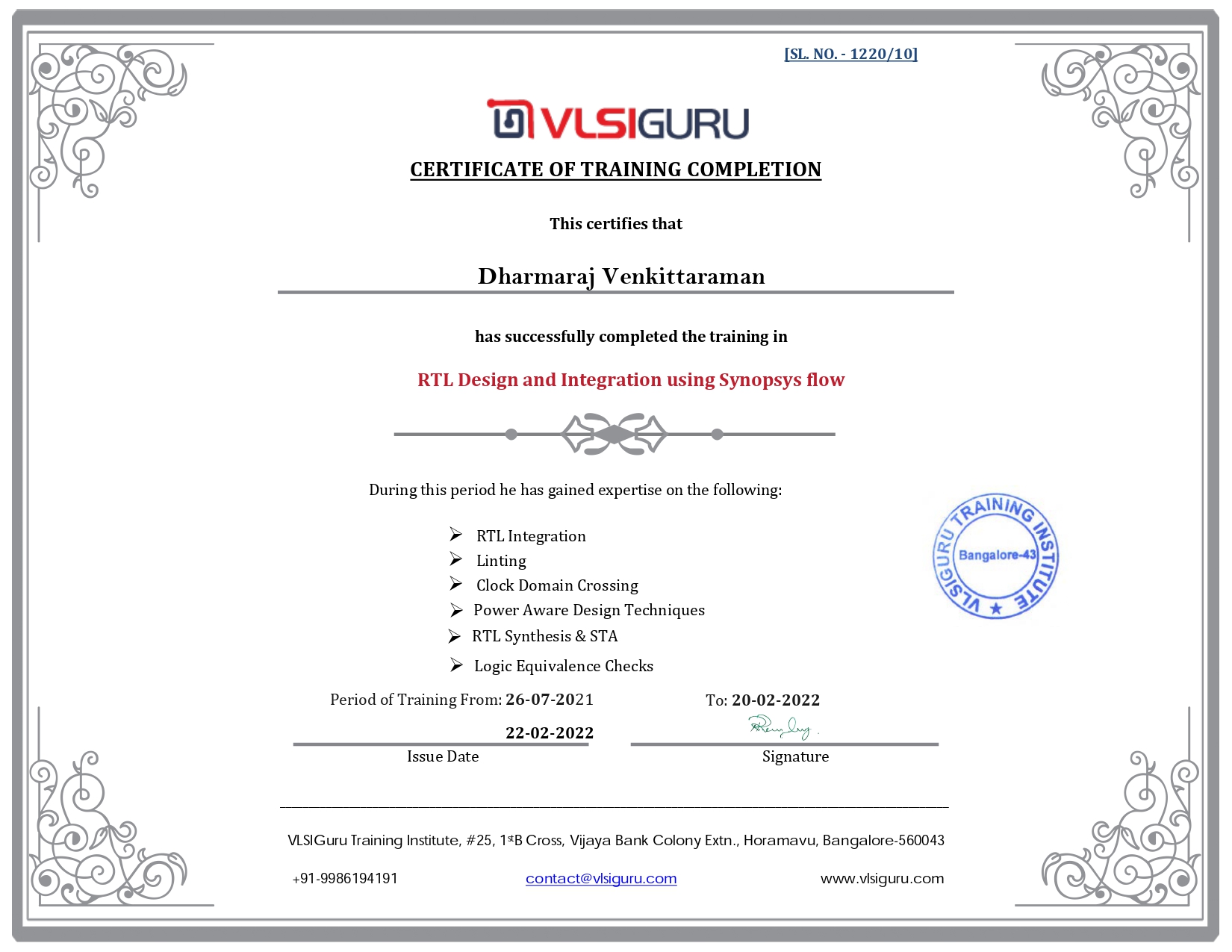- Revision Management
- IBM Clearcase
- GIT
- Project Management
- Detailed overview of project phases
- Significance of RTL integration in VLSI Design Flow
- Overview of RTL Integration
- Manual RTL integration
- Need for Tool based Integration
- CoreTools basics
- Usage model for IP packaging
- Usage model for IP integration
- RTL Lint basics
- Purpose of Linting
- Rules in Spyglass Lint
- Lint targets
- Lint_rtl goal
- Linting tools
- Spyglass tool flow and setup
- Rules in Spyglass lint
- Typical Lint targets
- Design read
- Goal selection and setup
- Run analysis and debug
- Lint hands on example
- CDC basics
- Clock domains and clock groups
- Principles of Synchronous design
- CDC synchronization techniques
- CDC problems and solutions
- Issues in CDC flow – Single bit crossing and multi bit crossing
- CDC flow for burst data
- Constraints versus Waivers
- Capturing design intent using CDC constraints
- Spyglass tool setup
- Run analysis and debug
- Abstract CDC flow
- Hierarchical waiver in SoC CDC methodology
- Introduction to Low Power
- Need for low power design
- Understanding power intent
- Types of power consumption
- Power reduction techniques
- Special cells for low power techniques
- Power switches
- Isolation cells
- Level shifters
- Always on logic
- Retention registers
- UPF
- UPF commands
- UPF flow
- Power domains
- Power state table
- Retention strategies
- Isolation strategies
- Level shifting strategies
- VCLP tool flow
- Reading the design
- Reading Power intent and running VCLP checks
- VCLP run script
- Importance of SDC
- SDC basics
- Defining clock
- Defining interface timing
- Defining exception
- SDC implementation with hands on project
- Introduction to Synthesis
- Data Setup for DC
- Accessing Design and Library Objects
- Constraints: Reg-to-Reg and I/O Timing
- Constraints: Input Transition and Output Loading
- Constraints: Multiple Clocks and Exceptions
- Constraints: Complex Design Considerations
- Post-Synthesis Output Data
- LEC basics
- Need for LEC?
- Logic Equivalence checks
- Combinational Equivalence
- Sequential Equivalence
- Transaction Equivalence
- Logic Equivalence checks
- Setup mode
- Mapping mode
- Compare mode
- Formal verification
- FormalPro tool overview
- Formality tool overview
- Input files
- Black box files
- Constraint files
- Debugging the failures
- Hands on project
- STA using Prime time flow
- Fixing setup and hold time violations
- Analyzing false and multi cycle paths
Course Overview
The training emphasizes both manual integration and tool-driven approaches, including developing glue logic for block connectivity, running static checks, and performing synthesis and timing closure. Participants will gain practical experience with industry-standard tools such as Synopsys Spyglass (Lint and CDC), Design Compiler for synthesis, and PrimeTime for STA. These tools enable fast turnarounds in time-critical projects, where integration engineers are expected to deliver accurate design tags within tight timelines.
Key Areas Covered
-
RTL integration methodology and glue logic development
-
Linting (static analysis) – rules, guidelines, debugging, and best practices
-
CDC (Clock Domain Crossing) checks using Synopsys Spyglass
-
Unified Power Format (UPF) for multi-power domain SoCs
-
SDC, synthesis, logical equivalence checking (LEC), and static timing analysis (STA)
-
Tool-based integration and automation flows
Learning Outcomes
-
Ability to perform end-to-end RTL integration on SoC-level projects
-
Strong understanding of Lint and CDC methodologies with in-depth debugging skills
-
Expertise in handling UPF for low-power design and power intent specification
-
Hands-on experience with synthesis, STA, and design signoff flows
-
Practical knowledge of industry-grade tools for time-critical integration tasks
By the end of the course, participants will be capable of independently managing RTL integration, ensuring connectivity, timing closure, and low-power intent verification in advanced semiconductor designs.
| Course | RTL design and integration with hands on projects |
|---|---|
| Duration | Live training : 20 weeks eLearning : 120 hours |
| Tool access | 3.5 months Spyglass, RTL integration tools, VCLP, Design compiler, Primetime, Formality. |
| Fee | Live training : INR 40000 + GST eLearning : INR 32000 + GST |
| Mode of training | Course offered in live training for a minimum of 10 participants or corporate training. |
| Schedule | Live training: 3 hours per week on Saturday and Sunday eLearning : Dedicated doubt clarification sessions on weekends |
- Course presentations for all topics
- Session notes
- Lab documents with detailed steps
- User guides
- Course presentations for all topics
- Session notes
- Lab documents with detailed steps
- User guides
- Yes, Course fee also includes support for doubt clarification sessions even after course completion
- Student can email queries
- Option to meet in person to clarify doubts
- Digital design fundamentals
- Verilog coding basics
- Each session of course is recorded, missed session videos will be shared
- Yes, You will have option to view the recorded videos of course for the sessions missed
- You will have option to repeat the course any time in next 1 year
Experienced Trainer
- Multiple trainers each with 15+ years of working on entire RTL integration flow
- Trainer with exposure to Synopsys and Cadence flow


- 1-1 Dedicated Mentor Support
- 24/7 Tool Access
- Multiple mock interviews
- Industry Standard Projects
- Support with resume update
